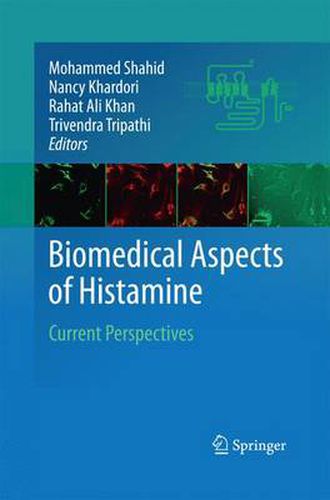Readings Newsletter
Become a Readings Member to make your shopping experience even easier.
Sign in or sign up for free!
You’re not far away from qualifying for FREE standard shipping within Australia
You’ve qualified for FREE standard shipping within Australia
The cart is loading…






This title is printed to order. This book may have been self-published. If so, we cannot guarantee the quality of the content. In the main most books will have gone through the editing process however some may not. We therefore suggest that you be aware of this before ordering this book. If in doubt check either the author or publisher’s details as we are unable to accept any returns unless they are faulty. Please contact us if you have any questions.
Since its identification by Sir Henry H. Dale a century ago, histamine has become one of the most important multifunctional biogenic amines in the field of biomedicine. The pharmacological effects of histamine are mediated through four types of membrane histamine receptors; H1R, H2R, H3R and H4R, which are all heptahelical G-protein-coupled receptors. It has been known to play the broadest spectrum of activities in various physiological and pathological conditions including cell proliferation, differentiation, hematopoiesis, embryonic development, regeneration, wound healing, aminergic neurotransmission and numerous brain functions, secretion of pituitary hormones, regulation of gastrointestinal and circulatory functions, cardiovascular system, as well as inflammatory reactions, modulation of the immune response, endocrine function and homeostasis, and other important areas.
This book is a compendium of the current state of established and investigational literature on Histamine, its receptors and their Agonists and antagonists. It provides a comprehensive overview of histamine biology in the field of biochemistry, cell biology, molecular biology, immunology, allergy, neurobiology, pharmacology, microbiology and reproductive biology. The first section on Histamine biology and physiology leads into subsequent sections on enzymology, pharmacology, regulation of the immune system and cell proliferation and role in allergic and other diseases including acid peptic diseases, inflammatory diseases, autoimmune and cancer diseases, nervous system, reproductive functions and hematopoiesis. The compilation of chapters in the book presents the most recent advances in histamine research and bridges the basic and clinical aspects of histamine biology.
$9.00 standard shipping within Australia
FREE standard shipping within Australia for orders over $100.00
Express & International shipping calculated at checkout
This title is printed to order. This book may have been self-published. If so, we cannot guarantee the quality of the content. In the main most books will have gone through the editing process however some may not. We therefore suggest that you be aware of this before ordering this book. If in doubt check either the author or publisher’s details as we are unable to accept any returns unless they are faulty. Please contact us if you have any questions.
Since its identification by Sir Henry H. Dale a century ago, histamine has become one of the most important multifunctional biogenic amines in the field of biomedicine. The pharmacological effects of histamine are mediated through four types of membrane histamine receptors; H1R, H2R, H3R and H4R, which are all heptahelical G-protein-coupled receptors. It has been known to play the broadest spectrum of activities in various physiological and pathological conditions including cell proliferation, differentiation, hematopoiesis, embryonic development, regeneration, wound healing, aminergic neurotransmission and numerous brain functions, secretion of pituitary hormones, regulation of gastrointestinal and circulatory functions, cardiovascular system, as well as inflammatory reactions, modulation of the immune response, endocrine function and homeostasis, and other important areas.
This book is a compendium of the current state of established and investigational literature on Histamine, its receptors and their Agonists and antagonists. It provides a comprehensive overview of histamine biology in the field of biochemistry, cell biology, molecular biology, immunology, allergy, neurobiology, pharmacology, microbiology and reproductive biology. The first section on Histamine biology and physiology leads into subsequent sections on enzymology, pharmacology, regulation of the immune system and cell proliferation and role in allergic and other diseases including acid peptic diseases, inflammatory diseases, autoimmune and cancer diseases, nervous system, reproductive functions and hematopoiesis. The compilation of chapters in the book presents the most recent advances in histamine research and bridges the basic and clinical aspects of histamine biology.